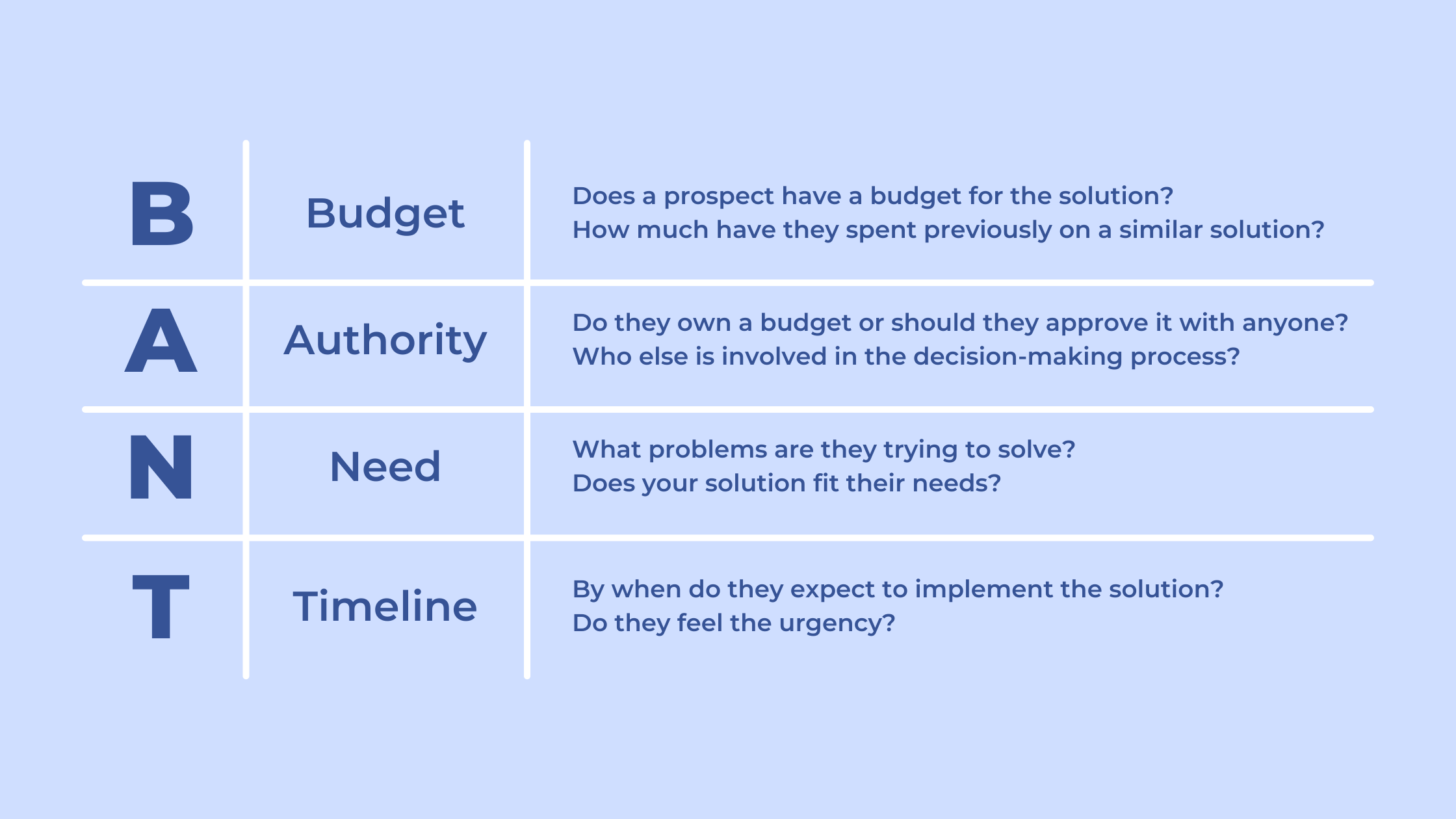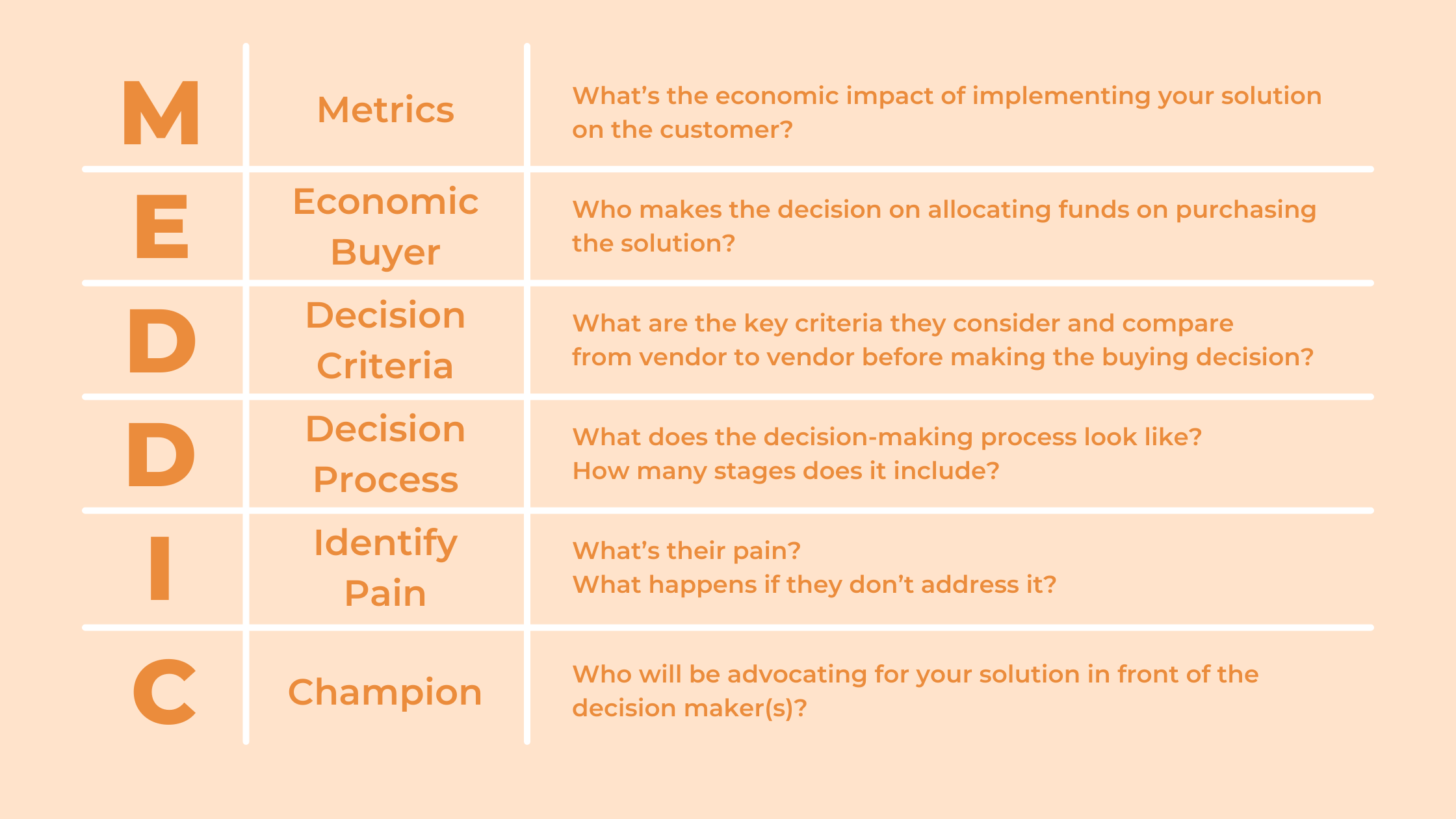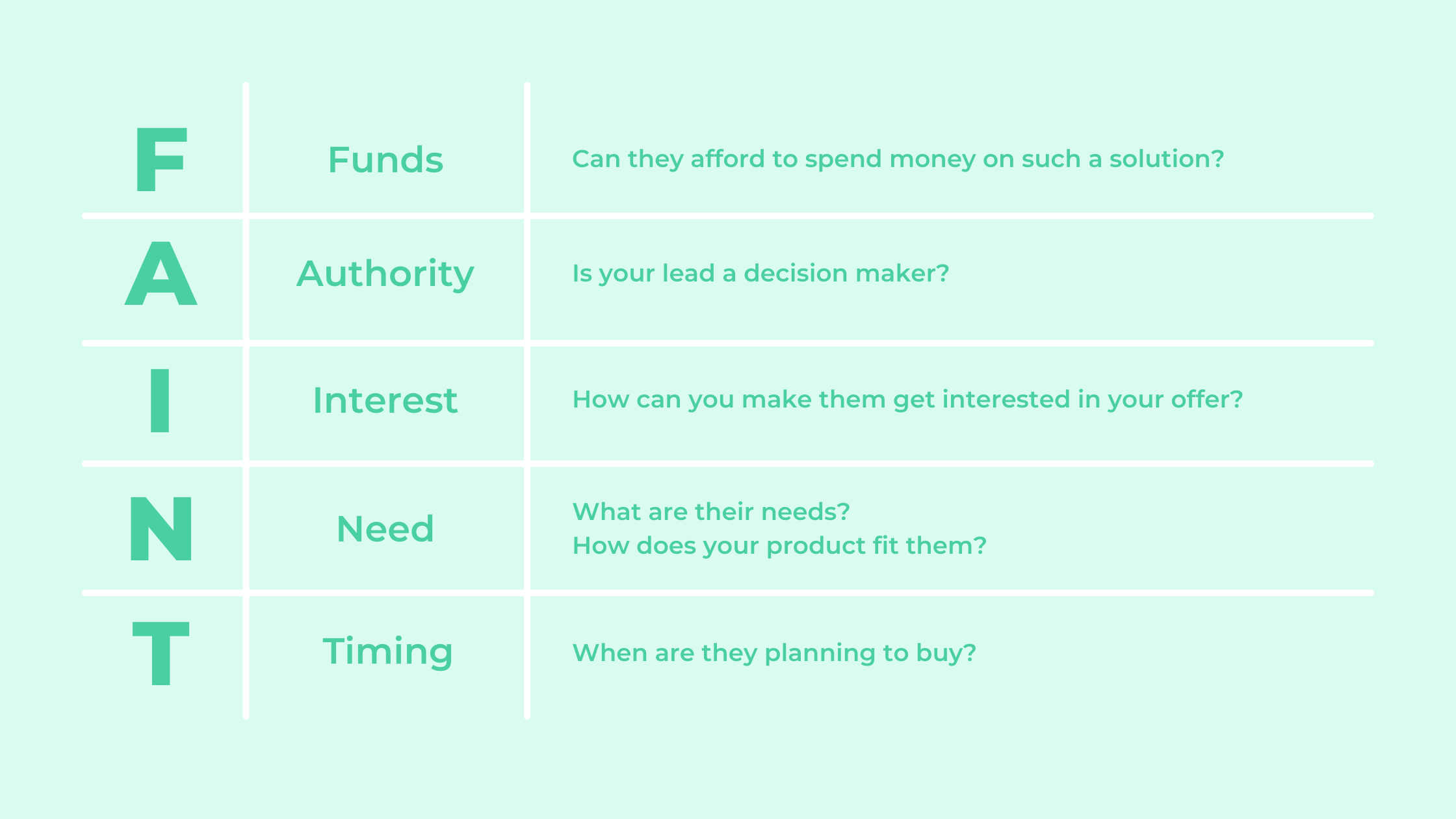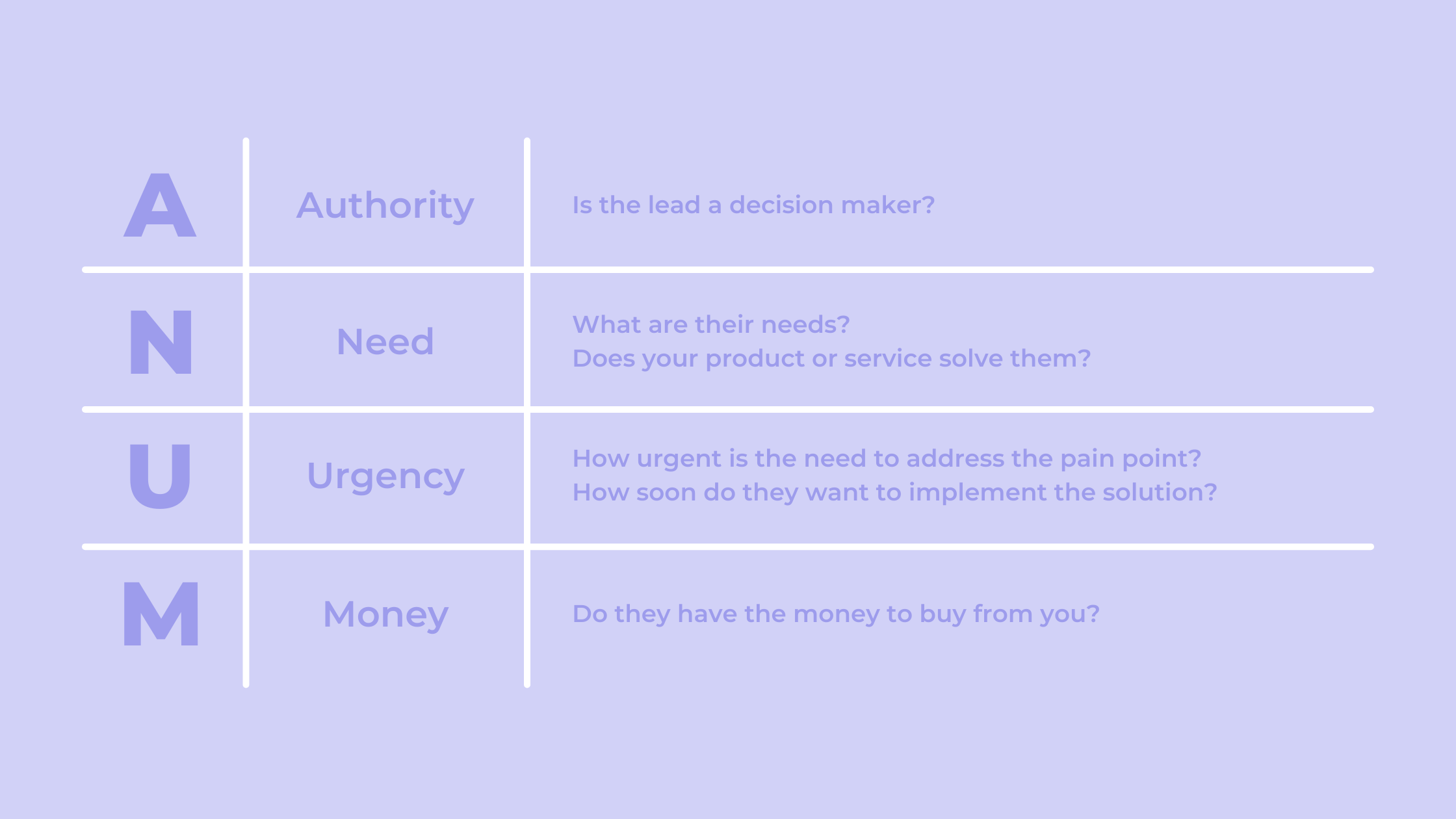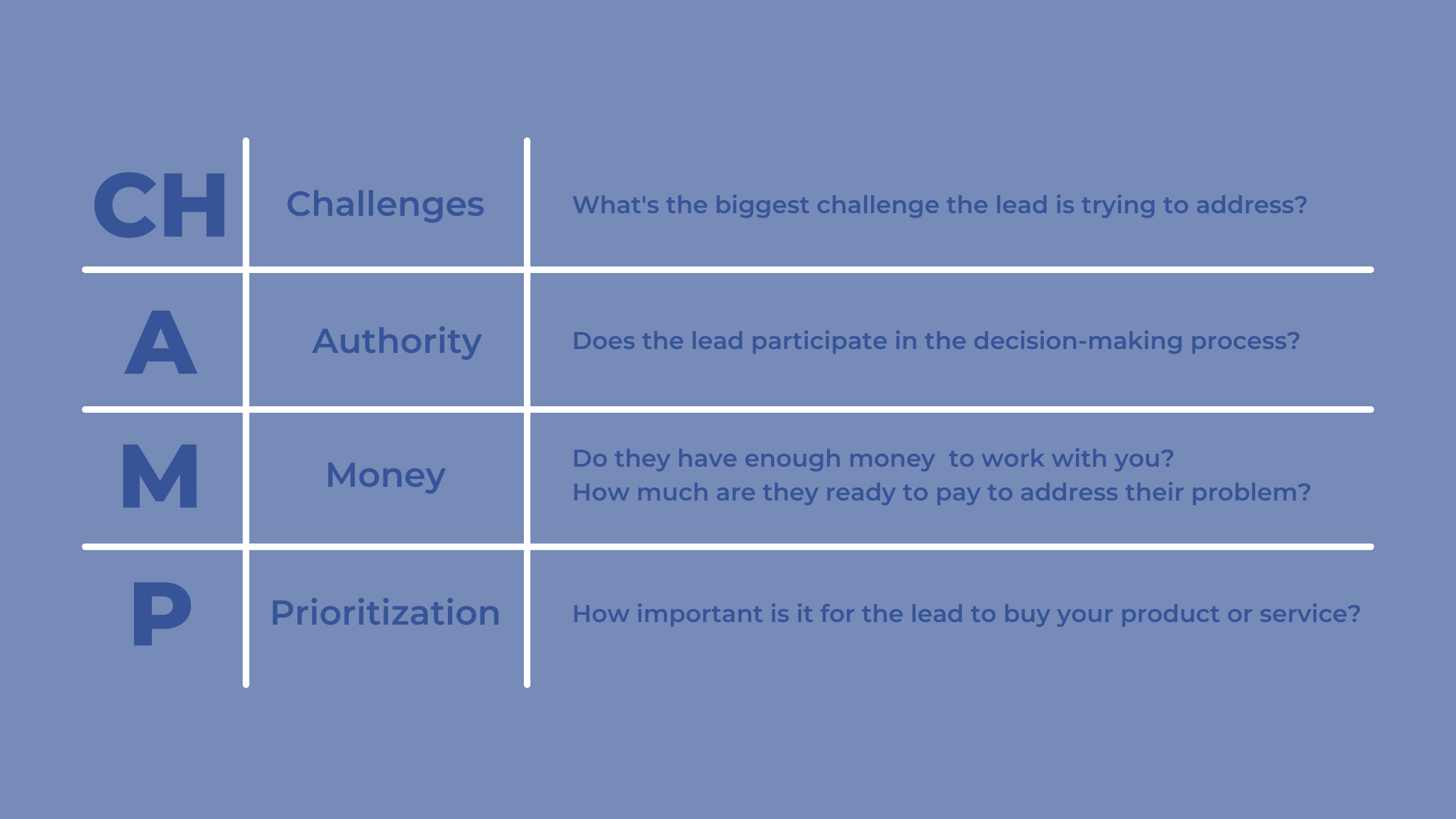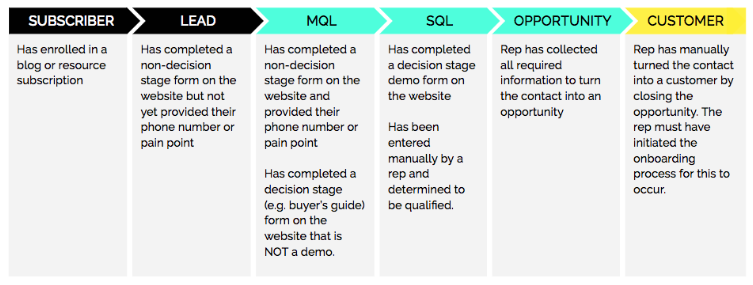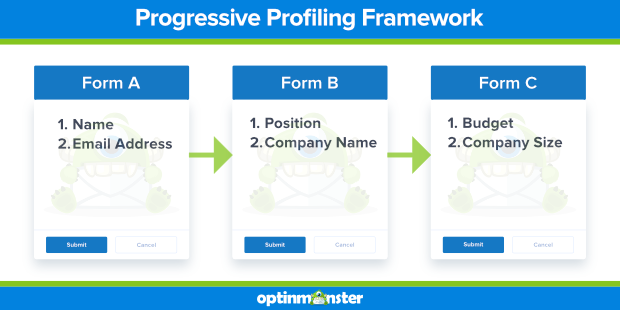Lead generation is crucial to the success of any B2B or B2C company. But it makes no sense if you don’t manage to drive qualified leads.
Typically, just over a quarter of the leads marketers pass to sales representatives fit this description.
How do you prevent your sales team from spending their priceless time on unqualified leads and let them focus on converting potential customers? You need a solid lead qualification process. Read on to discover how to build the one that makes a difference in your business operations.
What is lead qualification?
Lead qualification is a set of actions aimed at categorizing leads based on how likely they are to purchase from you. This is done in order to prioritize opportunities and distribute leads that are at different stages of the buyer’s journey between marketing and sales teams.
The process typically includes multiple steps and is only possible when you have enough data on your leads. Therefore, the way you generate leads, e.g. whether you require all the necessary information in your lead gen forms or not, will greatly affect the effectiveness of your lead qualification process.
Why lead qualification is essential for business growth
Lead qualification is crucial for multiple reasons:
-
- First of all, salespeople are able to focus on the top potential customers without wasting their time on leads who are not likely to convert.
- As a result of the priorities set right, conversion rates go up.
-
- You can set up personalized marketing campaigns for leads who aren’t sales-qualified yet. This way, you nurture leads at the very beginning of their path to purchase and move them down the sales funnel.
- Long term, you’ll drive more qualified leads. When you analyze incoming submissions from people who expressed interest in your marketing materials, you see the strengths and weaknesses of your campaigns and can adjust accordingly.
- Retention rates grow. With a deep understanding of leads’ struggles come ideas for addressing these problems. When qualifying leads before selling to them, you can offer solutions that address your customers’ pain points and encourage repeat purchases.
- And finally, lead qualification enables you to re-discover your target audience, their interests, and pain points. Each time you take a close look at a lead’s profile, you get a chance to come up with ideas for improving your nurturing process or even discover ways to modify your product or service.
The impact of proper lead qualification is reflected in many aspects of business development. It ensures more effective business operations, better communication with prospective and existing customers, higher retention rates, and more.
Lead qualification frameworks
Lead qualification can be approached in different ways. There are 5 major lead qualification frameworks:
- BANT
- MEDDIC
- FAINT
- ANUM
- CHAMP
Each method fits different business models so it’s important to understand each one before making a choice.
BANT
BANT is an abbreviation that stands for Budget, Authority, Need, and Timeline. The words composing the name of the framework are the basis for qualifying questions, such as:
- Budget: Does a prospect have a budget for the solution? How much have they spent previously on a similar solution?
- Authority: Do they own the budget or should they approve it with anyone? Who else is involved in the decision-making process?
- Need: What problems are they trying to solve? Does your solution fit their needs?
- Timeline: By when do they expect to implement the solution? Do they feel the urgency?
According to the framework, a lead needs to meet at least three items to be vetted by the sales team.
The framework focuses on the willingness of the potential customer to allocate funds towards purchasing your product or service. “Budget” is the first word in the BANT acronym, which also reflects its importance in the framework.
MEDDIC
MEDDIC stands for Metrics, Economic Buyer, Decision Criteria, Decision Process, Identify Pain, and Champion.
The framework requires a deep examination of the company’s buying processes. Who makes the buying decision, how they make it, and what motivates them are the key questions for businesses using this framework. A more detailed investigation involves answering the following questions:
- Metrics: What’s the economic impact of implementing your solution on the customer?
- Economic Buyer: Who makes the decision on allocating funds to purchasing the solution?
- Decision Criteria: What are the key criteria they consider and compare from vendor to vendor before making the buying decision?
- Decision Process: What does the decision-making process look like? How many stages does it include?
- Identify Pain: What’s their pain? What happens if they don’t address it?
- Champion: Who will be advocating for your solution in front of the decision-maker(s)?
This framework is typically chosen by fast-growing startups and enterprises. These companies spend a lot to make the conversion happen, and the approach allows them to increase forecasting accuracy.
FAINT
The FAINT framework focuses on aspects such as Funds, Authority, Interest, Need, and Timing.
It aims at identifying whether a prospective customer can afford to buy from you and then (if the answer is ‘yes’) finding ways of generating interest in the product.
Unlike the BANT framework where the project budget is prioritized, FAINT suggests looking at the lead’s overall cash flow. It’s a task for your sales team to convince them of the importance to allocate the budget needed to address their pain points.
Some of the questions that should be answered to qualify leads based on this framework are:
- Funds: Can they afford to spend money on such a solution?
- Authority: Is your lead a decision-maker?
- Interest: How can you make them get interested in your offer?
- Need: What are their needs? How does your product fit them?
- Timing: When are they planning to buy?
ANUM
ANUM prioritizes the lead’s role in the decision-making process over their ability to invest in this relationship. It stands for Authority, Need, Urgency, and Money.
The ANUM framework requires answering the following questions:
- Authority: Is the lead a decision-maker?
- Need: What are their needs? Does your product or service solve them?
- Urgency: How urgent is the need to address the pain point? How soon do they want to implement the solution?
- Money: Do they have the money to buy from you?
Companies often opt for ANUM as talking to a decision-maker shortens the sales process significantly.
In the intricate landscape of business interactions, the choice of engaging decision-makers streamlines the sales process, akin to the careful orchestration of perplexity and burstiness in effective communication.
Just as companies seek to expedite sales by targeting decision-makers, the art of crafting a successful sales process involves a harmonious blend of tactics, with each step mirroring the diverse elements that contribute to compelling content.
By aligning with decision-makers, businesses reflect the strategic interplay of complexities and variations, reducing the convolutions of the sales journey and navigating it toward fruitful outcomes.
CHAMP
CHAMP stands for Challenges, Authority, Money, and Prioritization.
To qualify prospects, you need to focus on their challenges first. In this model, creating an opportunity is only possible after you identify the lead’s problem and how relevant it is to what you offer.
Next, you can move on to identifying the lead’s role in the decision-making process, whether they have a budget, and what the company priorities are.
- Challenges: What’s the biggest challenge the lead is trying to address?
- Authority: Does the lead participate in the decision-making process?
- Money: Do they have enough money to work with you? How much are they ready to pay to address their problem?
- Prioritization: How important is it for the lead to buy your product or service?
MQLs vs. SQLs
What happens to qualified leads? What if a lead is serious about buying from you, but they are able to invest in your product or service starting from the next year? What if they don’t have an estimated timeline?
Let’s try to answer these questions.
There are multiple types of leads that can be classified as unqualified, sales-qualified, marketing-qualified, conversion-qualified, and product-qualified. Still, the most common and widely used classification focuses on two types of leads: marketing-qualified (MQLs) and sales-qualified leads (SQLs).
- MQLs are leads who have engaged with your company in a certain way, but they aren’t ready to hear from your sales representatives yet. They require targeted marketing campaigns, like educational content, email newsletters, and more. The final goal of nurturing MQLs is turning them into SQLs and passing them to a sales team.
- SQLs are prospective customers who are ready to move to the sales process.
So, if a lead lacks some features after you analyze them using the chosen lead qualification framework, but you don’t want to disqualify and lose them, you can define them as MQL.
However, not all MQLs will turn into SQLs. Make sure you don’t spend too much time on MQLs that have no potential for becoming your customers.
How to qualify leads effectively
Lead qualification isn’t done in a blink of an eye. Here are 7 steps to qualify leads and improve your sales results.
Identify distinctive features of a qualified lead
Before you define leads as qualified or unqualified, determine what features distinguish a potential buyer. To do this, identify who your ideal customers are.
ICP, or an ideal customer profile, is a description of a person or a company that is most likely to buy your product or service. If you have a diverse target market, you might have multiple customer groups. Typically, a B2B company has 3-5 customer profiles.
You’ll find comprehensive customer profiles useful both when you build a lead generation strategy and qualify leads that come from less targeted marketing campaigns.
You can distinguish leads based on the demographics, interests, needs, online behavior, and/on any other criteria that indicates how relevant these people are to your offer(s).
These characteristics should translate into the questions you’ll be asking on lead capture forms and during your conversations with potential customers.
Note that enhancing LQ necessitates the incorporation of a robust sales process. Cultivating your leads with effectiveness has the potential to substantially elevate the likelihood of converting them into clientele, thus underscoring the importance of dedicating resources to perfect this operational element.
A proficient sales process needs to harmonize with the path taken by your buyers, offer explicit procedures for attracting and qualifying potential consumers, and be subject to perpetual improvements informed by data derived from consistent sales endeavours.
Choose a solution for customer relationship management
Choosing the right CRM system is half the battle of streamlining your lead qualification process. Implementing a quality CRM platform will help you keep your customer profiles in order and set criteria for qualifying leads automatically.
Once a lead fills in a form on your website and their answers are added to your CRM, they’ll be checked against the customer profile characteristics you’ve defined. Based on the results, the lead can be marked as MQL/SQL or disqualified completely. This is just one of the multiple ways to use CRM tools for lead qualification. You might also want to implement lead scoring, lead grading, or any other method of qualifying potential customers.
However, not every CRM platform has all the necessary features to enable you to qualify leads automatically. Below are some of the top-notch platforms that can assist you in the lead qualification automation process:
- Salesforce
- HubSpot
- Pipedrive
- Zoho CRM
Understand the buyer’s journey
The understanding of the buyer’s journey is useful at every stage of the lead generation campaign creation, whether you’re coming up with an idea of a lead magnet, building a landing page, or creating a lead capture form.
When you work on a lead magnet, you should already have an idea of where in the buyer’s journey are people who will be interested in this specific asset. This will make the whole lead qualification process easier.
Enhancing your understanding of the buyer’s journey and seamlessly incorporating it into your lead qualification tactics can result in significant enhancements in your ability to forge connections with and successfully convert potential leads. Throughout every phase of this progression, you will uncover distinctive chances to actively interact with potential buyers and exert a favorable influence on their decision-making process.
Embracing the intricacies of the buyer’s journey allows you to tailor your approach and tailor your messaging to meet the specific needs and preferences of each prospect, ultimately guiding them toward a successful conversion.
Let’s take a look at a real-life scenario. Say, you’re running a wellness marketing campaign that’s promoting a guide where the benefits of dietary supplements are explained.
What does the content say about people requesting it? It says these are people in the early stages of their buyer’s journey. They’ve shown some interest in improving their health conditions and would like to learn about the benefits of dietary supplements.
Before qualifying them, it’s best to nurture them with a few more content campaigns that include videos, case studies, and customer stories.
The other campaign of yours includes a free assessment that will help your prospects pick the right supplements. Most leads taking it have already collected enough information on the subject and are now close enough to making the purchase decision. After taking a glance at the resulting data, your marketing team can pass the contact information and the assessment results to the sales representatives for them to book calls with prospective customers.
Implement progressive profiling
You might have heard the fewer questions you include in your lead capture forms, the better. That’s true when you want to increase conversion rates for your forms.
But how do you keep conversions on the same level and collect as much data on your leads as possible? Progressive profiling is the answer.
Progressive profiling is a technique that allows you to build up profiles of your prospective customers step-by-step by using dynamic lead capture forms.
It’s not uncommon for companies to distribute different lead magnets across their websites. In this case, one lead might fill in the lead capture form many times. With progressive profiling, you’ll make use of these submissions.
Each time a lead returns for additional assets, they’re asked different questions within lead capture forms. This way, you won’t be scaring away new leads with extensive surveys but will be gradually building up multi-level prospective customer accounts.
Use interactive quizzes
It’s no secret that quizzes are one of the best ways to generate leads for your business. However, they can also contribute to the lead qualification process greatly.
By including the right questions in your interactive quizzes, you’ll better understand your leads and what stage of the customer journey they’re in.
Ideally, a quiz will include up to 10 questions, each offering at least 3 different answer options. Assign scores that only you can see to each answer. Based on the number of points each lead gets, you’ll be able to segment your audience into different groups automatically.
It’ll take a lot of A/B testing before you develop a quiz that includes questions that engage the right audience and collects all the necessary information. But the results are worth the effort.
Ask the right questions
For every stage of the lead qualification process, there are questions that should be answered by either a marketing team or sales representatives internally.
But it can happen that the questions you’ve included in your lead capture forms aren’t enough to qualify leads effectively. It’s often the case for companies with long sales processes or a large contract value. In this scenario, both you and your prospective client or customer will benefit from a discovery call.
Schedule a call with your leads to get to know them and their challenges better. Avoid positioning it as a sales call but rather a conversation aimed at figuring out whether you and your prospect are a good fit for each other or not. People who are really looking for the right solution will be grateful for such an opportunity and won’t mind jumping on a quick call that will save their time in the future.
Some of the questions that you might want to discuss during the discovery call include:
- What are typical day-to-day activities in your role?
- When did you realize the need for the solution to your problem first?
- Have you already had experience with similar solutions?
- If so, why are you looking for an alternative to switch to?
- How do you think our product or service can help you?
- What are the potential pitfalls on the way to implementing the solution?
Mind that this is a qualifying call, and you shouldn’t try to close the deal right away.
Nurture leads and watch how they interact with your brand
It’s not likely you’ll be able to say whether a lead is sales-qualified or not after their first interaction with your company. It’s fine to give it a time.
Create an email marketing campaign that will be educating your leads on the topic, sharing customer stories, promoting fresh webinars, and more. In a few weeks, take a look at how your leads interact with the campaign and qualify those who have expressed interest in your resources.
Conclusion
We’ve covered the most important steps you should take to always distinguish qualified leads from people who have nothing to do with your ideal customer profile. It’s your turn to go get a CRM platform and build the process from scratch.
Start with defining your ideal customer profiles – make a list of your prospective customers’ characteristics and compare them against your leads’ qualities.
Bio:
Adelina is a Content Marketer at Joinative, a native advertising agency and SaaS. She’s responsible for building marketing partnerships, establishing content collaborations, and developing actionable resources for advertisers.
My Gravatar account is associated with [email protected].
